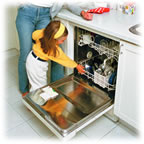
Buying Tips for Vinyl Flooring
There is very little about today’s vinyl flooring that is like what mom’s kitchen floor used to be.
These new vinyl floors have new finishes, different construction and new types of backing. They are designed for better wear, clearer pattern definition, and easier to maintain and install. Manufacturers have gone primarily to cushioned products with wider widths to reduce the number of seams needed. Even though those old inlaid floors your mom used to have were rugged, innovations like ToughGuard backing from Armstrong help their cushion vinyl floors resist tearing.
In past years, many of the backing materials experienced back staining that would show through the cushion layer making them visible on the surface. Now newer backings like Armstrong’s ToughGuard are designed to resist back staining.
Most residential sheet flooring offer no-wax performance and a wide variety of colors and patterns–more than any other flooring product.
Generally speaking, cushion flooring is the most economical of all flooring choices.
Some products are designed to help you reduce subfloor preparation costs
Next to ceramic tile, vinyl flooring installation demands properly prepared subflooring. Many of the printed cushion vinyl products are thin and when they are installed with a full spread of adhesive over a poorly prepared subfloor, irregularities can telegraph through. Products designed for perimeter or loose lay installation will greatly reduce the effects of subfloor irregularities while lowering subfloor preparation costs. In fact, many of these products can be installed over you existing flooring. We should point out that full spread installations are the most durable over time. Humidity and temperature for example can affect fiberglass backings that are loose laid improperly.
Special considerations when choosing sheet vinyl flooring
Beware of asphalt driveways as asphalt can react to certain shoes and transfer into the vinyl resulting in permanent staining. Be careful when moving or dragging heavy objects across the floor as it often results in permanent damage to vinyl surfaces.



